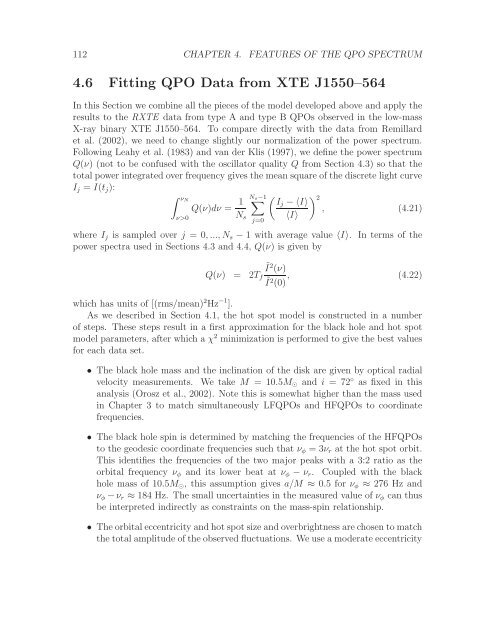Radiation Transport Around Kerr Black Holes Jeremy David ...
Radiation Transport Around Kerr Black Holes Jeremy David ...
Radiation Transport Around Kerr Black Holes Jeremy David ...
Create successful ePaper yourself
Turn your PDF publications into a flip-book with our unique Google optimized e-Paper software.
112 CHAPTER 4. FEATURES OF THE QPO SPECTRUM<br />
4.6 Fitting QPO Data from XTE J1550–564<br />
In this Section we combine all the pieces of the model developed above and apply the<br />
results to the RXTE data from type A and type B QPOs observed in the low-mass<br />
X-ray binary XTE J1550–564. To compare directly with the data from Remillard<br />
et al. (2002), we need to change slightly our normalization of the power spectrum.<br />
Following Leahy et al. (1983) and van der Klis (1997), we define the power spectrum<br />
Q(ν) (not to be confused with the oscillator quality Q from Section 4.3) so that the<br />
total power integrated over frequency gives the mean square of the discrete light curve<br />
I j = I(t j ):<br />
∫ νN<br />
Q(ν)dν = 1 N∑<br />
s−1( ) 2 Ij − 〈I〉<br />
, (4.21)<br />
N s 〈I〉<br />
ν>0<br />
where I j is sampled over j = 0, ..., N s − 1 with average value 〈I〉. In terms of the<br />
power spectra used in Sections 4.3 and 4.4, Q(ν) is given by<br />
j=0<br />
Q(ν) = 2T f<br />
Ĩ 2 (ν)<br />
Ĩ 2 (0) , (4.22)<br />
which has units of [(rms/mean) 2 Hz −1 ].<br />
As we described in Section 4.1, the hot spot model is constructed in a number<br />
of steps. These steps result in a first approximation for the black hole and hot spot<br />
model parameters, after which a χ 2 minimization is performed to give the best values<br />
for each data set.<br />
• The black hole mass and the inclination of the disk are given by optical radial<br />
velocity measurements. We take M = 10.5M ⊙ and i = 72 ◦ as fixed in this<br />
analysis (Orosz et al., 2002). Note this is somewhat higher than the mass used<br />
in Chapter 3 to match simultaneously LFQPOs and HFQPOs to coordinate<br />
frequencies.<br />
• The black hole spin is determined by matching the frequencies of the HFQPOs<br />
to the geodesic coordinate frequencies such that ν φ = 3ν r at the hot spot orbit.<br />
This identifies the frequencies of the two major peaks with a 3:2 ratio as the<br />
orbital frequency ν φ and its lower beat at ν φ − ν r . Coupled with the black<br />
hole mass of 10.5M ⊙ , this assumption gives a/M ≈ 0.5 for ν φ ≈ 276 Hz and<br />
ν φ −ν r ≈ 184 Hz. The small uncertainties in the measured value of ν φ can thus<br />
be interpreted indirectly as constraints on the mass-spin relationship.<br />
• The orbital eccentricity and hot spot size and overbrightness are chosen to match<br />
the total amplitude of the observed fluctuations. We use a moderate eccentricity
















